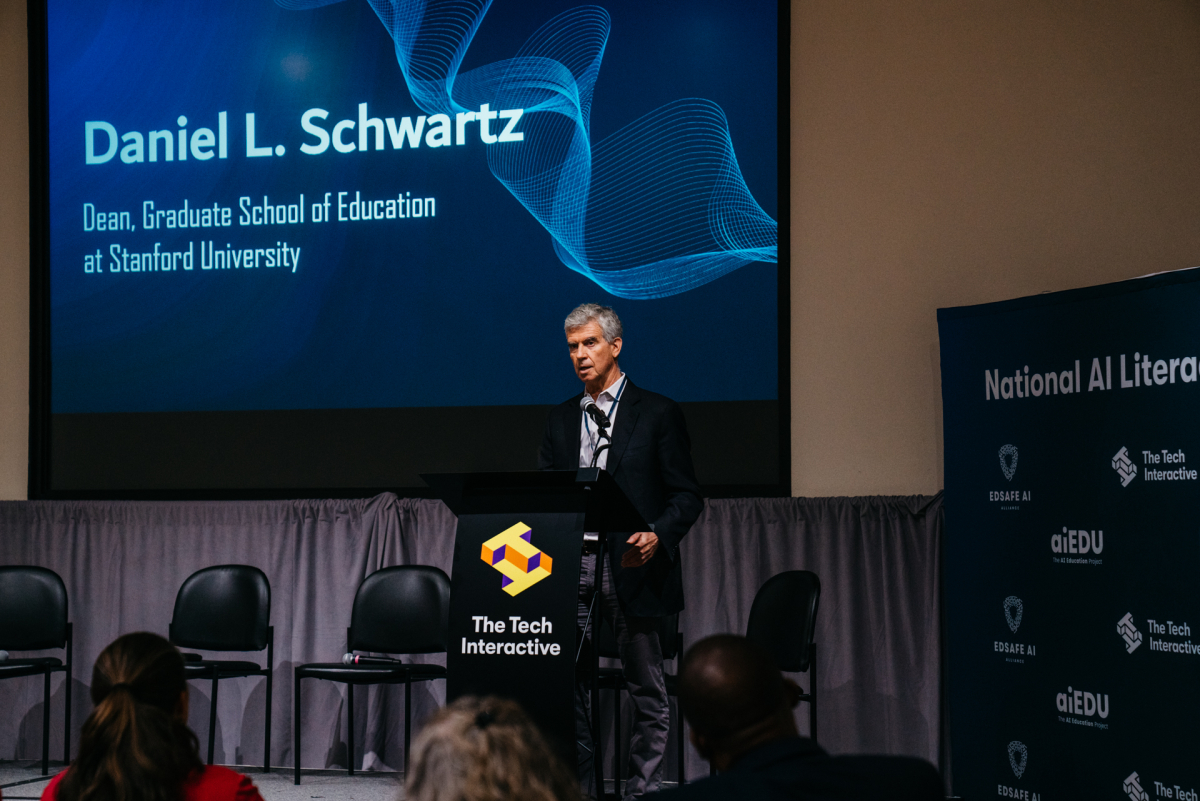
Some educational technologies are those that schools choose to adopt and implement, like interactive whiteboards and tablets in classrooms. Others come in on their own, like ChatGPT and other generative artificial intelligence (AI) chatbots — leaving school leaders scrambling to establish policies and best practices that bolster the learning process.
On April 19, more than 100 educational stakeholders gathered at The Tech Interactive in San Jose for the inaugural National AI Literacy Day, to collaborate and strategize around a learning tool that’s taken schools by storm. One of three in-person events held that day (the other two took place in New York City and Washington, D.C.), the summit raises awareness and creates solutions around literacy in AI.
“A literate student needs a meta understanding of AI — its personal and social policies, as well as its capabilities, implications, biases, and use,” said Dan Schwartz, dean of Stanford Graduate School of Education and faculty director of the Stanford Accelerator for Learning (an academic partner for the event), who opened a panel discussion on the use of technology in classrooms. “We need to help students learn this, and we need to do better than we did with social media.”
Around 1,100 students on field trips visited The Tech during the event. (Photo: Eloisa Tan, The Tech Interactive)
Schwartz went on to say that getting ahead of AI in the education space means figuring out how to teach and learn using the tool to co-create strong bodies of knowledge, integrating it into curriculums, and thinking beyond just applying AI to existing educational methods.
“The other side of literacy is more about the future, rather than making sure we can maintain old strategies of the past,” he said.
The event featured remarks from U.S. Deputy Secretary of Education Cindy Marten and San Jose Mayor Matt Mahan, as well as panel discussions that covered topics including community, access and ethics in relation to AI. Additionally, around 1,100 K-12 students were at the Tech Interactive on field trips to commemorate National AI Literacy Day.
Researchers from CRAFT (Classroom-Ready Resources About AI for Teaching) a Stanford project developing free AI Literacy resources for high school teachers, led 32 school leaders in a lunch-and-learn session, discussing privacy, equity, resource demand and student success in thinking about the creation and implementation of AI-related school policies.
“One of our goals is to support school leaders and superintendents in having conversations with one another about the issues or challenges they may be facing with AI in their districts,” said Christine Bywater, a member of the curricular resource design team for CRAFT and associate director of Stanford’s Center to Support Excellence in Teaching.
“We’re having them look through a framework to start to think about the questions they should be asking before they even start to venture into thinking about artificial intelligence, so that we can all make really strong decisions.”
Leaders in education from throughout the Bay Area shared concerns, came up with questions, and workshopped ways forward using the CRAFT framework.
“I think what we’re learning is that our scholars are discovering things faster than we are sometimes, and we want to get ahead of that,” said Mariah Butron, curriculum coordinator for Navigator Schools. “We do that by making sure we have safety nets for students, and the literacy and resources in place to help the families understand what’s happening with AI in the classroom.”
A key takeaway for many educators was the idea that successfully navigating generative AI in schools will require communication across sectors.
“I’m excited to see the partnerships that are happening across civic leaders, schools, businesses, and museums like the Tech,” said Mark Silver, MA ‘97, head of school at Hillbrook School. “I think it’s that type of collaboration that’s going to be essential in order for schools to effectively find ways to implement AI, and [to use] it in a way that will positively impact the student experience.”
Subscribe to our monthly newsletter.